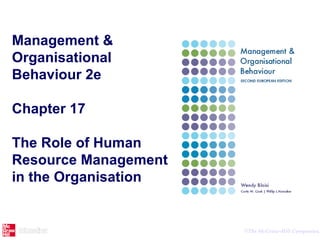
Bloisimobpp17
- 1. Management & Organisational Behaviour 2e Chapter 17 The Role of Human Resource Management in the Organisation ©The McGraw-Hill Companies,
- 2. Learning Outcomes • After studying this chapter you will be able to: • Identify the historical developments and their impact on HRM • Outline the development and functions of HRM • Understand the differences between HRM and Personnel management • Evaluate ‘hard’ and ‘soft’ approaches to HRM • Understand how diversity is an issue HR practice • Consider the HRM as an international issue ©The McGraw-Hill Companies,
- 3. Historical Development • The Late 15th Century • Scientific Management • Fordism • Human Relations Movement • The First World War • Between the wars • The Second World War • The Post War Years ©The McGraw-Hill Companies,
- 4. Post 70s Features of HRM • The collective bargaining role • The implementer of legislation role • The bureaucratic role • The social conscience of business role. • A growing performance improvement role ©The McGraw-Hill Companies,
- 5. Personnel Versus Human Resource Management • Sometimes means the same things. • HRM can mean a particular philosophy ©The McGraw-Hill Companies,
- 6. Traditional HR Functions ©The McGraw-Hill Companies,
- 7. Distinguishing Between HRM and PM ©The McGraw-Hill Companies,
- 8. Guest’s Model of HRM • Linked to the strategic management of an organisation. • Seeks commitment to organisational goals • Focuses on the individual needs rather than the collective workforce. • Enables organisations to devolve power and become more flexible • Emphasises people as an asset to be positively utilised by the organisation. ©The McGraw-Hill Companies,
- 9. Storey’s Definition of HRM • 'Human capability and commitment'. Storey argues that this is what differentiates organisations. • Strategic importance of HRM. It needs to be implemented into the organisational strategy and needs to be considered at the highest management level. • The long term importance of HRM. It needs to be integrated into the management functions and is seen to have importance consequences on the ability of the organisation to achieve its goals. • The key functions of HRM which are seen to encourage commitment rather than compliance. ©The McGraw-Hill Companies,
- 10. Points of Difference between Personnel and IR Practices and HRM Practices Dimension Personnel/IR HRM Beliefs and assumptions 1. Contract Careful delineation of written Aim to go 'beyond contract' contracts 2. Rules Importance of devising clear 'Can-do' outlook; impatience with rules/mutuality 'rule' 3. Guide to management Procedures 'Business need' action 4. Behaviour referent Norms/custom and practice Values/mission Managerial task Monitoring Nurturing vis a vis labour 6. Nature of relations Pluralist Unitarist 7. Conflict Institutionalised De-emphasised ©The McGraw-Hill Companies,
- 11. S trate gic as pe c ts Personnel /IR HRM 8. Key relations Labour management Customer 9. Initiatives Piecemeal Integrated 10.Corporate plan Marginal to Central to 11. Speed of decision Slow Fast ©The McGraw-Hill Companies,
- 12. Line manage me nt Personnel / IR HRM 12. Management role Transactional Transformational leadership 13. Key managers Personnel/IR General/business/line specialists managers 14. Communication Indirect Direct 15. Standardisation High (for example Low (for example 'parity' an issue) 'parity' not an issue) 16. Prized Negotiation Facilitation management skills ©The McGraw-Hill Companies,
- 13. Key Levers Personnel / IR HRM 17. Selection Separate, marginal task Integrated, key task 18. Pay Job evaluation (fixed Performance related grades) 19. Conditions Separately negotiated Harmonisation 20. Labour management Collective bargaining Towards individual contracts contracts 21. Thrust of relations with Regularised through Marginalised (with exception stewards facilities and training of some bargaining for change models) 22. Job categories and Many Few grades 23. Communication Restricted flow Increased flow 24. Job design Division of labour Teamwork 25. Conflict handling Reach temporary truces Manage climate and culture 26. Training and Controlled access to Learning companies development courses 27. Foci of attention for Personnel procedures Wide ranging cultural, interventions structural and personnel strategies © The McGraw-Hill Companies,
- 14. A Model of the Shift to HRM ©The McGraw-Hill Companies,
- 15. Hard HRM • The 'hard' approach rooted in the manpower planning approach is concerned with aligning human resource strategy with business strategy ©The McGraw-Hill Companies,
- 16. Soft HRM • The 'soft' approach is rooted in the human relations school, with concern for workers' outcomes and encourages commitment to the organisation by focussing on workers' concerns. ©The McGraw-Hill Companies,
- 17. The Human Resource System ©The McGraw-Hill Companies,
- 18. The Harvard Model of Human Resource Management ©The McGraw-Hill Companies,
- 19. Guest’s Model of HRM ©The McGraw-Hill Companies,
- 20. Strategic Management and Environmental Pressures ©The McGraw-Hill Companies,
- 21. The Human Resource Cycle ©The McGraw-Hill Companies,
- 22. The Context of HRM ©The McGraw-Hill Companies,
- 23. The HR Functions ©The McGraw-Hill Companies,
- 24. Summary • An HR manager needs to recognise that Human Resource Management is in a constant state of change. • HR management has progressed from an ad hoc role to the professional body of the CIPD. ©The McGraw-Hill Companies,
- 25. Summary continued 1 • The terms Personnel management and HRM have are part of the debate that inform the role of the HR manager. • HRM is viewed as a means of moving people along to achieve organisational goals through staffing, performance, change management and administrative objectives. ©The McGraw-Hill Companies,
- 26. Summary continued 2 • Personnel Management has often been seen as a bridge between the employer and the employee. • "Hard" HRM characterised by the Michigan model is seen as viewing people as a resource needed to achieve organisational goals. • "Soft" HRM characterised by the Harvard model is seen as a method of developing strategies to encourage employee©The McGraw-Hill Companies,
- 27. Summary continued 3 • The functions of HR include: planning and resourcing; recruitment and selection; training and development; pay and reward and employee relations. • Understanding the HR context in relation to the organisational and external context is important for an effective HR manager. ©The McGraw-Hill Companies,
